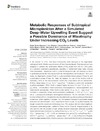Identificador persistente para citar o vincular este elemento:
https://accedacris.ulpgc.es/jspui/handle/10553/72325
| Title: | Metabolic Responses of Subtropical Microplankton After a Simulated Deep-Water Upwelling Event Suggest a Possible Dominance of Mixotrophy Under Increasing CO2 Levels | Authors: | Tames Espinosa, Maria Teresa Martínez Sánchez, Ico Romero Kutzner, Vanesa Coca Saenz De Albéniz, Josep Algueró-Muñiz, María Horn, Henriette G. Ludwig, Andrea Taucher, Jan Bach, Lennart Riebesell, Ulf Packard, Theodore Train Gómez Cabrera, María Milagrosa |
UNESCO Clasification: | 251001 Oceanografía biológica | Keywords: | Ocean acidification Mesocosms Nutrient fertilization Subtropical North-Atlantic Potential respiration, et al |
Issue Date: | 2020 | Journal: | Frontiers in Marine Science | Abstract: | In the autumn of 2014, nine large mesocosms were deployed in the oligotrophic subtropical North-Atlantic coastal waters off Gran Canaria (Spain). Their deployment was designed to address the acidification effects of CO2 levels from 400 to 1,400 μatm, on a plankton community experiencing upwelling of nutrient-rich deep water. Among other parameters, chlorophyll a (chl-a), potential respiration (Φ), and biomass in terms of particulate protein (B) were measured in the microplankton community (0.7–50.0 μm) during an oligotrophic phase (Phase I), a phytoplankton-bloom phase (Phase II), and a post-bloom phase (Phase III). Here, we explore the use of the Φ/chl-a ratio in monitoring shifts in the microplankton community composition and its metabolism. Φ/chl-a values below 2.5 μL O2 h−1 (μg chl-a)−1 indicated a community dominated by photoautotrophs. When Φ/chl-a ranged higher, between 2.5 and 7.0 μL O2 h−1 (μg chl-a)−1, it indicated a mixed community of phytoplankton, microzooplankton and heterotrophic prokaryotes. When Φ/chl-a rose above 7.0 μL O2 h−1 (μg chl-a)−1, it indicated a community where microzooplankton proliferated (>10.0 μL O2 h−1 (μg chl-a)−1), because heterotrophic dinoflagellates bloomed. The first derivative of B, as a function of time (dB/dt), indicates the rate of protein build-up when positive and the rate of protein loss, when negative. It revealed that the maximum increase in particulate protein (biomass) occurred between 1 and 2 days before the chl-a peak. A day after this peak, the trough revealed the maximum net biomass loss. This analysis did not detect significant changes in particulate protein, neither in Phase I nor in Phase III. Integral analysis of Φ, chl-a and B, over the duration of each phase, for each mesocosm, reflected a positive relationship between Φ and pCO2 during Phase II [α = 230·10−5 μL O2 h−1 L−1 (μatm CO2)−1 (phase-day)−1, R2 = 0.30] and between chl-a and pCO2 during Phase III [α = 100·10−5 μg chl-a L−1 (μ atmCO2)−1 (phase-day)−1, R2 = 0.84]. At the end of Phase II, a harmful algal species (HAS), Vicicitus globosus, bloomed in the high pCO2 mesocosms. In these mesocosms, microzooplankton did not proliferate, and chl-a retention time in the water column increased. In these V. globosus-disrupted communities, the Φ/chl-a ratio [4.1 ± 1.5 μL O2 h−1 (μg chl-a)−1] was more similar to the Φ/chl-a ratio in a mixed plankton community than to a photoautotroph-dominated one. | URI: | https://accedacris.ulpgc.es/handle/10553/72325 | ISSN: | 2296-7745 | DOI: | 10.3389/fmars.2020.00307 | Source: | Frontiers in marine science [ISSN 2296-7745], Mayo (2020) |
| Appears in Collections: | Artículos |
WEB OF SCIENCETM
Citations
2
checked on Jun 8, 2025
Page view(s)
164
checked on Feb 1, 2025
Download(s)
121
checked on Feb 1, 2025
Google ScholarTM
Check
Altmetric
Share
Export metadata
Items in accedaCRIS are protected by copyright, with all rights reserved, unless otherwise indicated.
